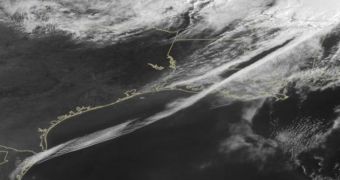A satellite in Earth's orbit was able to snap a photo of an impressive atmospheric phenomenon, which experts can only see once per month, or even less often. The orbital instrument saw what is known as an undular bore, but is also called a gravity wave train.
Such a formation can only develop in the planet's atmosphere, and is caused by wave disturbances produced when two massive air masses collide with each other. However, the two masses need to have very different temperatures in order for these structures to appear.
An undular bore was imaged on Wednesday, April 27, above the Golf of Mexico. This particular one can only be seen because clouds move in waves through its location.
According to atmospheric scientists, there is yet another critical condition for the formation of a such structure. This condition is also one of the reasons why the structures are seen so rare, and not daily.
The area in which they form needs to have been vacated recently, but only by cold weather fronts. In other words, if a warm front passes through, a undular bore will not form at that location.
Experts say that the appearance of the wave clouds is determined by the influence of Earth's gravitational pull, but also by the atmospheric transfer of energy between the host location and nearby storm fronts. This is also one of the reasons why these clouds travel in wave-like patterns.
When viewed from far away, they resemble the ripples caused by a rock falling into a small pond. The clouds can stretch as long as 8 kilometers (5 miles), and are capable of traveling at a top speed of between 16 and 95 kilometers per hour (10 to 59 miles per hour), Our Amazing Planet reports.
Scientists do not yet know for certain what role undular bores play in the atmosphere, but they argue that one of its primary functions could be to herald new storms. Despite being themselves produced by such events, they may contribute to additional ones developing by creating perturbations in the air.
These temperature and pressure variations contribute to the creation of new atmospheric fronts, which may then go on to form new gravity wave trains in return. The truth is that experts have very little idea of how these structures appear and why.
But scientists are taking steps to clear up this mystery. Understanding how and if storms control the formation of storms is a critical aspect of developing relevant climate change models.

 14 DAY TRIAL //
14 DAY TRIAL //